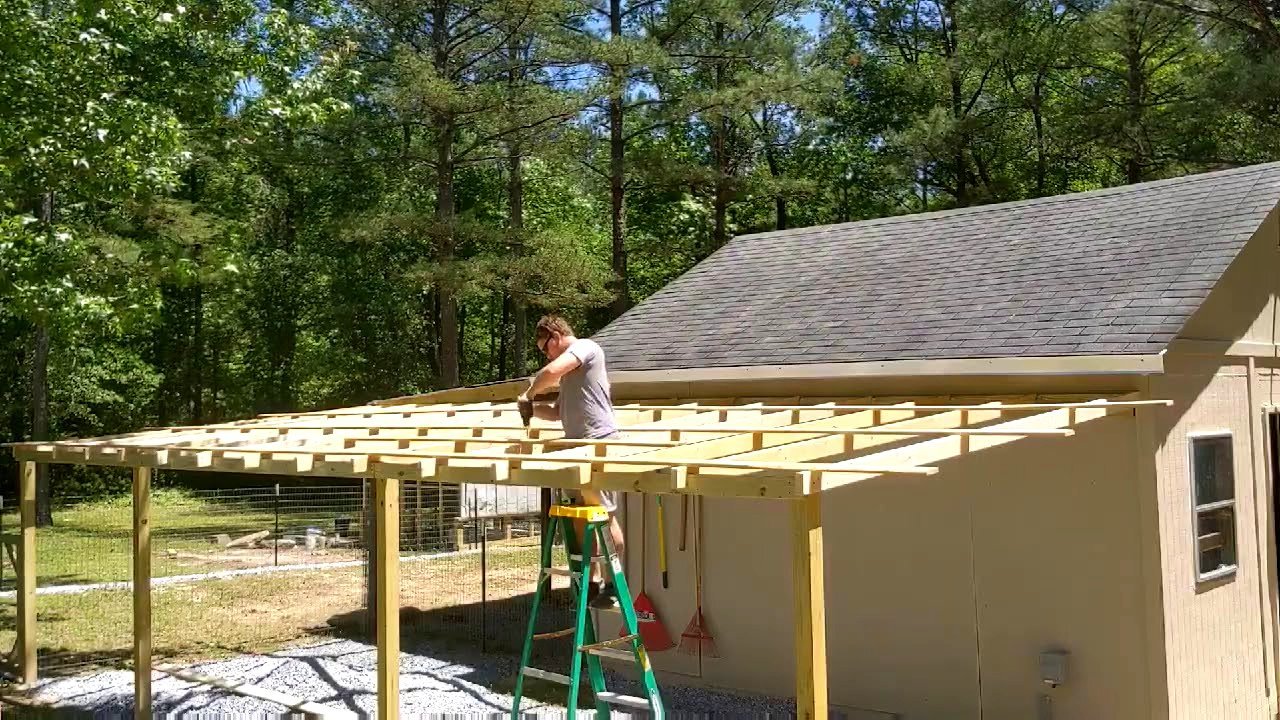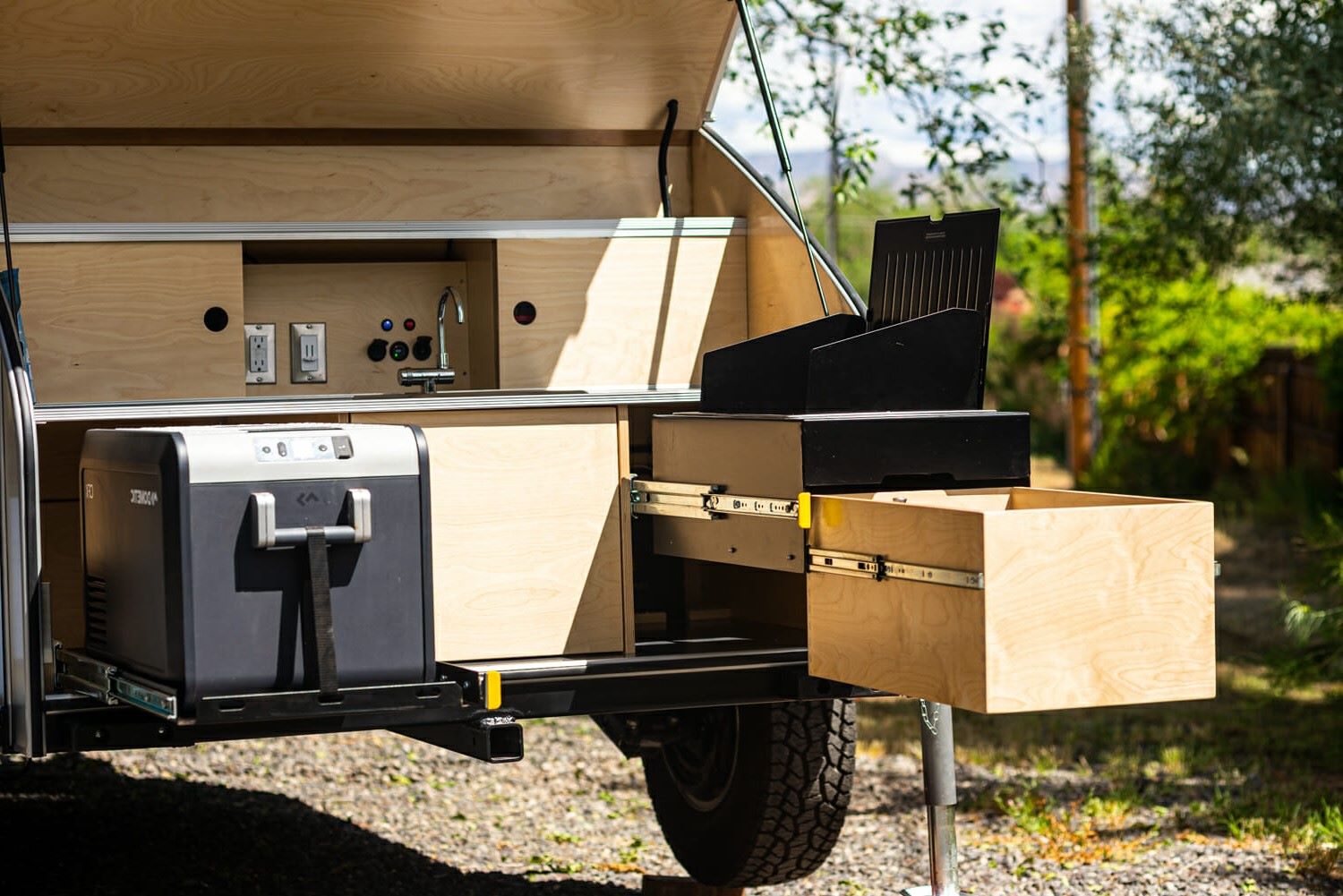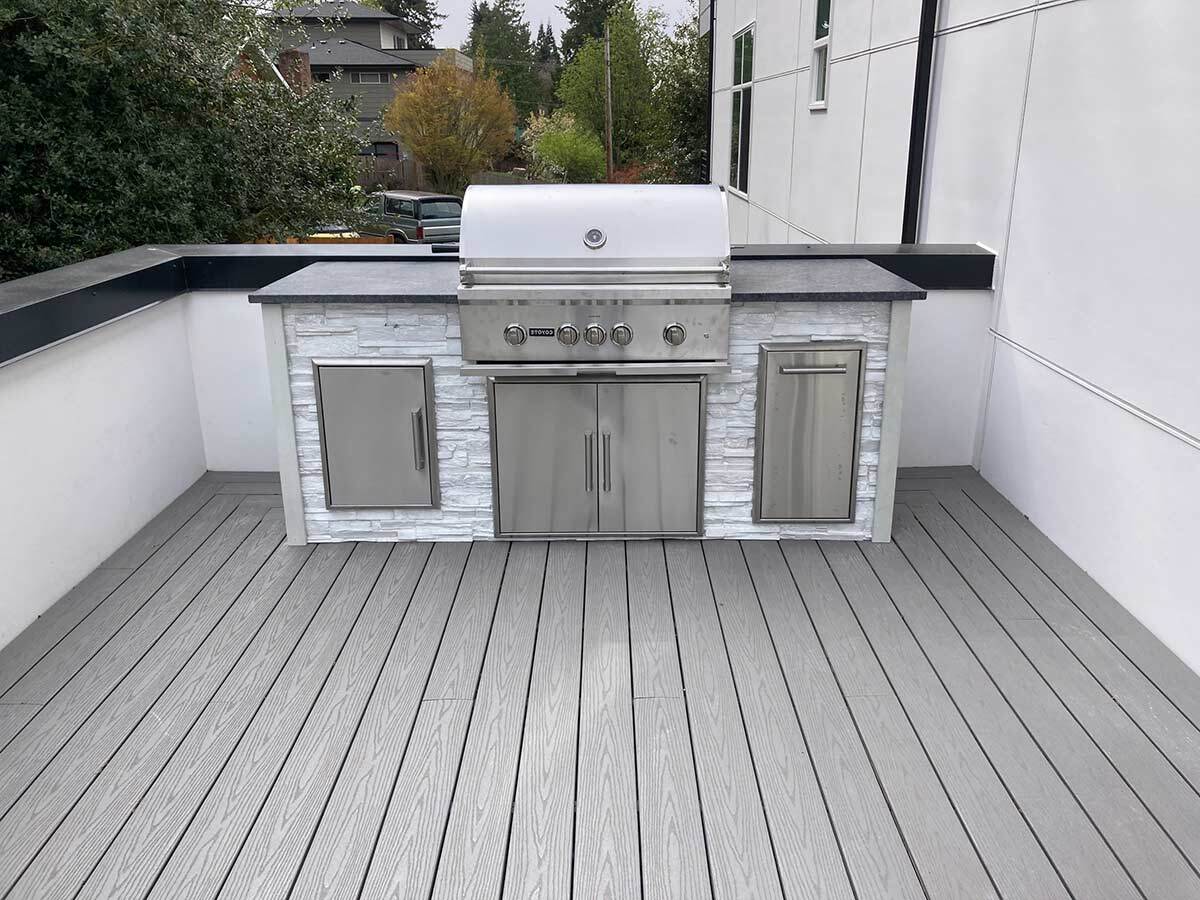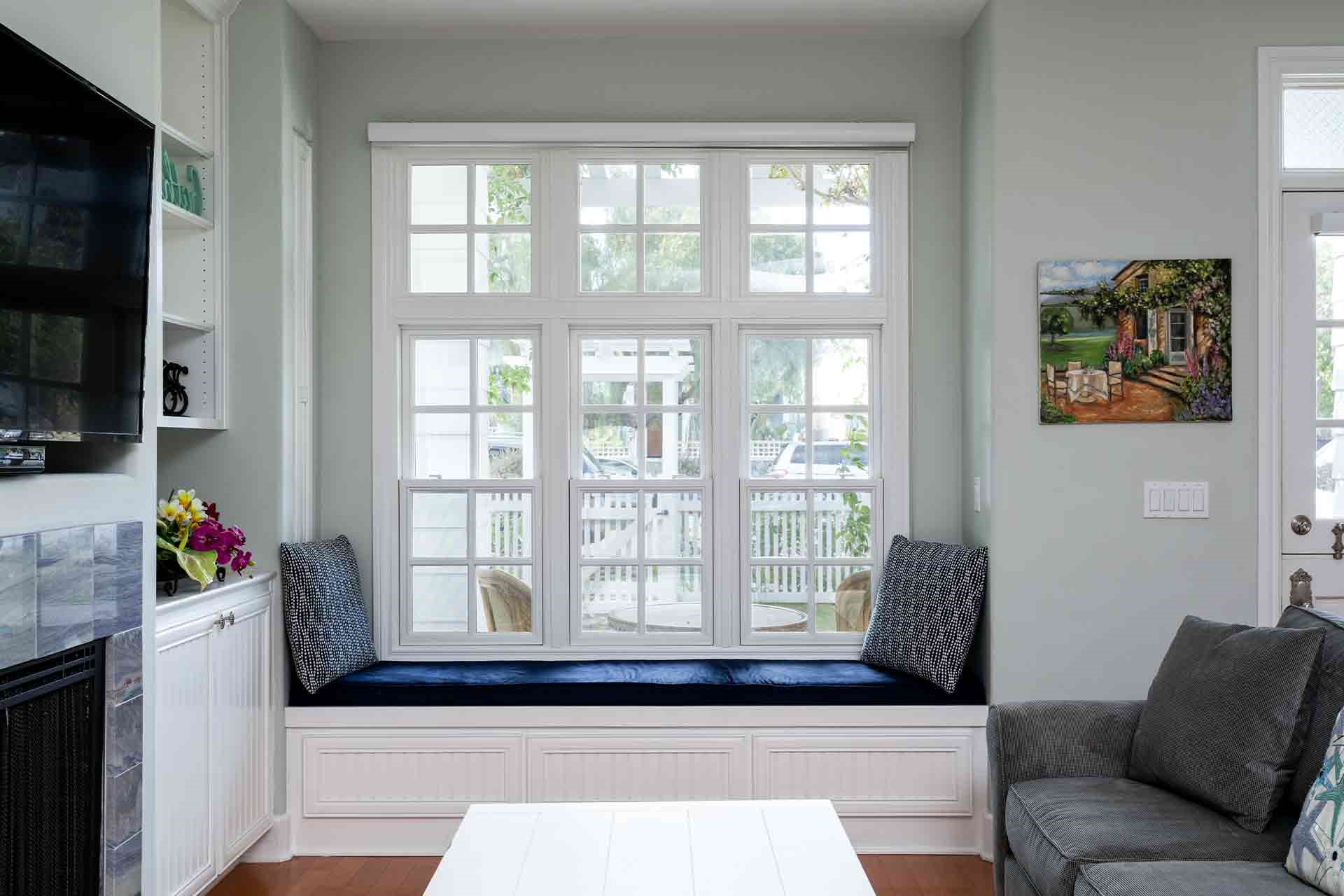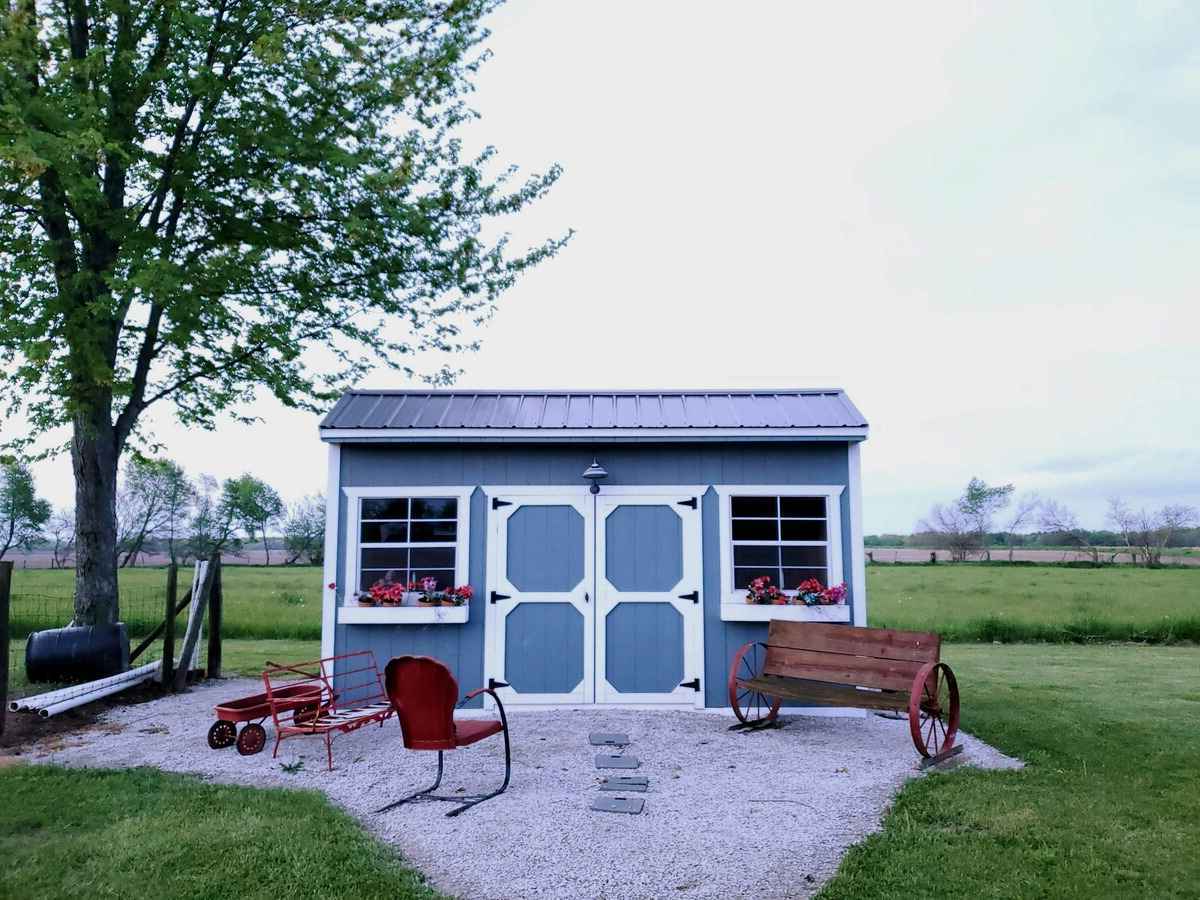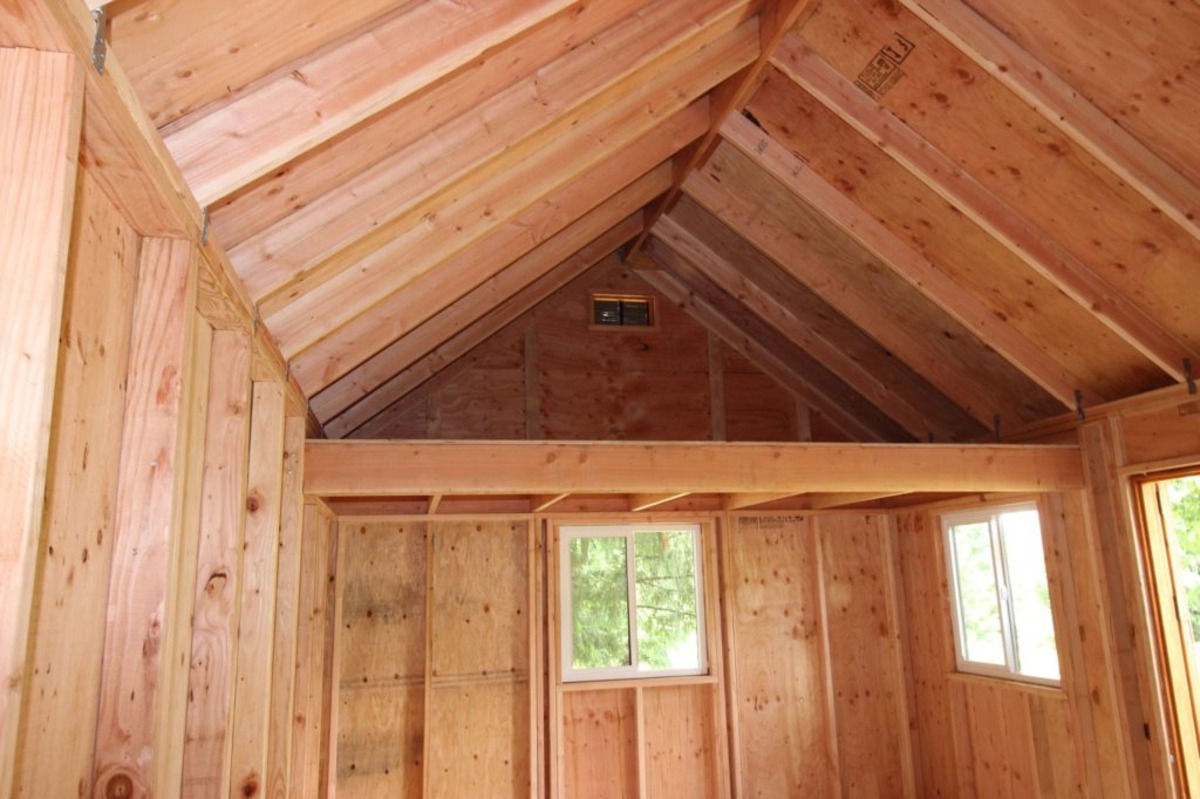Home>Create & Decorate>DIY & Crafts>Potting Shed Plans: A DIY Guide To Building Your Own Garden Oasis
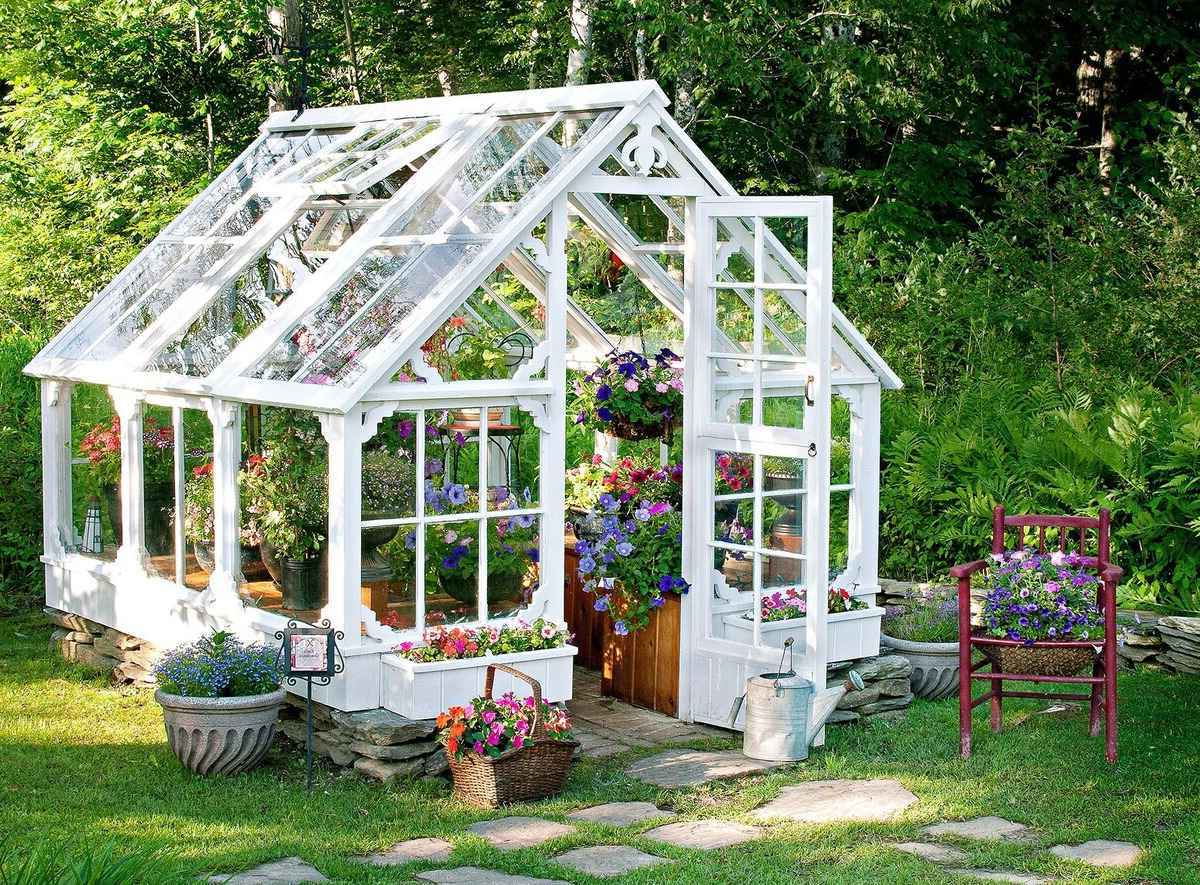

DIY & Crafts
Potting Shed Plans: A DIY Guide To Building Your Own Garden Oasis
Published: February 28, 2024

Senior Editor in Create & Decorate, Kathryn combines traditional craftsmanship with contemporary trends. Her background in textile design and commitment to sustainable crafts inspire both content and community.
Discover step-by-step potting shed plans for creating your own garden sanctuary with this comprehensive DIY guide. Explore creative DIY & Crafts projects to transform your outdoor space.
(Many of the links in this article redirect to a specific reviewed product. Your purchase of these products through affiliate links helps to generate commission for Twigandthistle.com, at no extra cost. Learn more)
Introduction
Welcome to the world of DIY potting sheds, where creativity meets functionality, and gardening enthusiasts can craft their own garden oasis. Whether you're a seasoned gardener or just starting to explore the joys of nurturing plants, a potting shed can be a valuable addition to your outdoor space. This comprehensive guide will walk you through the process of designing, building, and customizing your very own potting shed, tailored to your specific needs and preferences.
A potting shed is more than just a storage space for gardening tools and supplies; it's a sanctuary where you can immerse yourself in the therapeutic art of gardening. From sowing seeds to repotting plants, a well-designed potting shed can streamline your gardening tasks and provide a tranquil retreat for nurturing your green thumb.
In this guide, we'll delve into the essential aspects of creating your potting shed, from selecting the ideal location and materials to designing the layout and adding personalized touches. Whether you envision a quaint cottage-style shed nestled in a corner of your garden or a sleek, modern structure with ample workspace, the possibilities are as vast as your imagination.
By embarking on this DIY journey, you'll not only gain practical construction skills but also the satisfaction of bringing your vision to life. With careful planning and attention to detail, you can transform a humble pile of materials into a functional and aesthetically pleasing space that complements your gardening endeavors.
So, roll up your sleeves, gather your tools, and let's embark on this enriching venture to create a potting shed that reflects your passion for gardening and provides a haven for nurturing nature's bounties. Whether you're a seasoned DIY enthusiast or a novice builder, this guide will equip you with the knowledge and inspiration to embark on this fulfilling project. Let's dive in and uncover the art of crafting your very own garden oasis.
Read more: How to Make a DIY Planter Liner
Choosing the Right Location for Your Potting Shed
Selecting the perfect location for your potting shed is a crucial first step in the planning process. The ideal spot should not only accommodate the physical dimensions of the shed but also optimize functionality and aesthetic appeal. Here are essential factors to consider when choosing the right location for your potting shed:
1. Accessibility:
- Ensure that the location is easily accessible from your garden or outdoor space. This will streamline the process of transporting gardening supplies, plants, and tools to and from the shed. Additionally, easy access will save time and effort when you're engrossed in gardening tasks.
2. Natural Light:
- Position the shed in an area that receives ample natural light throughout the day. Adequate sunlight is essential for nurturing plants, starting seeds, and carrying out various gardening activities. Consider the sun's trajectory and how it will illuminate the interior of the shed during different times of the day.
3. Proximity to Water Source:
- If possible, place the potting shed near a water source, such as an outdoor faucet or rainwater collection system. This proximity will facilitate watering plants, filling watering cans, and cleaning gardening tools without the hassle of transporting water over long distances.
4. Shelter from Elements:
- Shield the shed from harsh weather conditions, such as strong winds and excessive exposure to direct sunlight. Positioning the shed near existing structures or trees can provide natural protection, ensuring that the interior remains comfortable for both you and your plants.
5. Aesthetic Harmony:
- Consider the visual impact of the shed's placement within your garden landscape. Aim to integrate the shed seamlessly into its surroundings, whether it's nestled among flower beds, nestled against a fence, or positioned as a focal point within the garden. Harmonizing the shed with its environment can enhance the overall appeal of your outdoor space.
6. Future Expansion:
- Anticipate future needs and potential expansion of your gardening activities. Choose a location that allows for potential expansion or the addition of complementary outdoor structures, such as a greenhouse or raised beds, as your gardening pursuits evolve.
By carefully evaluating these factors, you can pinpoint the optimal location for your potting shed, setting the stage for a harmonious blend of practicality and visual charm within your garden oasis.
Selecting the Best Materials for Your Potting Shed
The selection of materials for your potting shed is a pivotal decision that will influence the shed's durability, functionality, and aesthetic appeal. By choosing high-quality materials, you can ensure that your potting shed stands the test of time and provides a reliable space for your gardening endeavors. Here's a comprehensive overview of the best materials to consider for constructing your potting shed:
Read more: DIY Garage Shed Plans Guide
1. Lumber:
Opt for pressure-treated lumber or cedar, known for their resistance to rot, decay, and insect damage. These durable wood options are well-suited for outdoor structures and can withstand the rigors of varying weather conditions. Additionally, consider the dimensional lumber needed for framing, siding, and trim work, ensuring that it meets structural requirements while complementing the shed's design.
2. Roofing Materials:
Select roofing materials that offer superior weather protection and longevity. Asphalt shingles, metal roofing panels, or corrugated fiberglass panels are popular choices for potting shed roofs. Each option provides reliable shelter from the elements and can be tailored to complement the shed's overall aesthetic.
3. Windows and Doors:
Opt for windows and doors crafted from weather-resistant materials, such as vinyl or aluminum, to ensure durability and ease of maintenance. Consider energy-efficient glass options for windows to maximize natural light while minimizing heat loss or gain within the shed.
4. Hardware and Fasteners:
Invest in high-quality hardware and fasteners, including galvanized or stainless steel nails, screws, hinges, and latches. These components are essential for structural integrity and long-term performance, especially in outdoor environments where exposure to moisture and temperature variations can impact the shed's stability.
Read more: DIY Chuck Box Plans: How to Build Your Own
5. Flooring:
Choose a robust flooring material that can withstand foot traffic, heavy loads, and exposure to moisture. Pressure-treated plywood, concrete pavers, or composite decking are excellent options for potting shed floors, offering durability and ease of cleaning.
6. Siding and Trim:
Consider durable siding materials, such as engineered wood, fiber cement, or vinyl siding, to protect the shed's exterior from moisture and pests. Additionally, select trim materials that complement the chosen siding while providing a polished finish to the shed's architectural details.
By carefully evaluating and selecting the best materials for your potting shed, you can lay a solid foundation for a resilient and visually appealing outdoor structure. Prioritize quality, durability, and suitability for outdoor use when sourcing materials, ensuring that your potting shed becomes a steadfast companion in your gardening journey.
Designing Your Potting Shed Layout
Designing the layout of your potting shed is a pivotal phase that harmonizes functionality, aesthetics, and ergonomic efficiency. A well-considered layout can optimize the use of space, streamline gardening tasks, and create an inviting atmosphere within the shed. Whether you envision a compact and cozy workspace or a spacious multifunctional hub for gardening activities, the layout plays a defining role in shaping the shed's character.
1. Functional Zones:
Divide the interior space into distinct functional zones to accommodate various gardening activities. Consider allocating areas for potting and repotting, seed starting, tool storage, and workspace for arranging cut flowers or conducting small-scale plant maintenance. By delineating specific zones, you can create a well-organized environment that caters to different aspects of gardening without clutter or confusion.
Read more: How to Create a DIY Kitchen Garden
2. Work Surface Placement:
Strategically position work surfaces, such as potting benches or tables, to facilitate seamless workflow and accessibility. Placing work surfaces near windows can capitalize on natural light for tasks that require optimal visibility, such as seed sowing and plant propagation. Additionally, consider incorporating ample counter space for organizing tools, potting soil, and plant containers, ensuring a well-equipped and efficient workspace.
3. Storage Solutions:
Integrate practical storage solutions, including shelves, cabinets, and pegboards, to maintain a tidy and orderly environment. Efficient storage not only keeps gardening tools and supplies within reach but also minimizes clutter, allowing for smooth navigation and unhindered movement within the shed. Customizable storage options can adapt to your specific needs, accommodating items of varying sizes and shapes.
4. Ventilation and Lighting:
Prioritize adequate ventilation and lighting to create a comfortable and conducive environment for plant care and gardening activities. Incorporate windows that can be opened to promote air circulation, preventing stagnant air and excess humidity. Additionally, consider installing task lighting, such as LED fixtures, to illuminate work areas and ensure optimal visibility during evening or overcast conditions.
5. Personal Touches:
Infuse the layout with personalized touches that reflect your gardening style and preferences. Whether it's hanging decorative planters, displaying vintage gardening tools, or incorporating a cozy seating area for moments of respite, these embellishments can imbue the shed with charm and individuality, transforming it into a welcoming sanctuary for both practical tasks and leisurely pursuits.
By meticulously planning and designing the layout of your potting shed, you can tailor the interior space to align with your gardening rituals and aspirations. The layout serves as the canvas upon which your gardening activities unfold, fostering a harmonious and inspiring setting where your green thumb can flourish.
Building the Foundation and Frame
The foundation and frame of your potting shed form the structural backbone upon which the entire edifice rests. Building a sturdy foundation is essential for ensuring the stability and longevity of your shed, while the frame provides the framework for the shed's walls, roof, and overall structural integrity.
Foundation Construction
-
Site Preparation: Begin by clearing and leveling the ground where the shed will be situated. Remove any debris, rocks, or vegetation to create a smooth and even surface for the foundation.
-
Foundation Type: Choose a suitable foundation type based on your shed's size, local building codes, and personal preferences. Common options include concrete slab, concrete piers, or pressure-treated skids supported by concrete blocks. Each type offers distinct advantages in terms of cost, durability, and ease of installation.
-
Laying the Foundation: If opting for a concrete slab, prepare the formwork and pour the concrete to create a solid and level base for the shed. For pier or skid-based foundations, ensure proper spacing and alignment to support the shed's weight evenly.
Frame Construction
-
Selecting Lumber: Choose high-quality, pressure-treated lumber for the shed's frame to resist moisture, decay, and insect damage. The frame comprises the walls, roof trusses, and structural supports, forming the skeleton of the shed.
-
Framing Walls: Assemble the wall frames on a level surface, ensuring precise measurements and sturdy construction. Incorporate openings for windows and doors as per your shed's design, and brace the frames to maintain squareness and structural integrity.
-
Erecting the Frame: Once the wall frames are constructed, raise them into position and secure them to the foundation. Use fasteners such as nails or screws to anchor the frames securely, ensuring plumbness and alignment.
-
Installing Roof Trusses: If your shed design includes a pitched roof, assemble and install the roof trusses atop the wall frames. Ensure proper spacing and alignment of the trusses to support the roof structure effectively.
By meticulously executing the foundation and frame construction, you establish a solid groundwork for the subsequent phases of building your potting shed. The foundation provides stability and load-bearing capacity, while the frame forms the structural skeleton that will support the shed's walls, roof, and overall functionality. With careful attention to detail and precision in construction, you set the stage for a resilient and enduring potting shed that will stand as a testament to your craftsmanship and dedication to the art of DIY construction.
Installing Doors, Windows, and Roofing
The installation of doors, windows, and roofing marks a significant phase in the construction of your potting shed, as it transforms the skeletal structure into a functional and weather-resistant enclosure. Each component plays a crucial role in enhancing the shed's usability, comfort, and visual appeal, contributing to a well-rounded and inviting space for gardening activities.
Read more: DIY Window Herb Garden: Step-by-step Guide
Doors
Select a durable and weather-resistant door that complements the shed's design and provides secure access. Whether opting for a pre-hung exterior door or crafting a custom door from lumber, ensure proper measurements and alignment for a snug fit within the door opening. Install sturdy hinges and a reliable locking mechanism to safeguard the shed's contents and provide peace of mind.
Windows
Windows not only introduce natural light into the shed but also facilitate ventilation and visual connection with the surrounding garden. Choose energy-efficient windows that can be opened to promote air circulation, preventing the buildup of excess humidity. Properly seal the window frames to prevent water infiltration and ensure a snug and weather-tight installation.
Roofing
The choice of roofing material and the meticulous installation process are pivotal in safeguarding the shed from the elements. Whether opting for asphalt shingles, metal panels, or other roofing options, ensure proper underlayment and flashing to prevent water intrusion. Pay attention to the roof's pitch and drainage to facilitate the efficient shedding of rainwater and snow, preserving the shed's structural integrity and interior comfort.
By methodically installing doors, windows, and roofing, you fortify the shed against external elements while creating a welcoming and functional space for your gardening pursuits. Each component contributes to the shed's overall resilience and usability, ensuring that it stands as a reliable and inviting haven within your garden oasis.
Adding Shelving and Workbenches
The integration of shelving and workbenches within your potting shed elevates its functionality, organization, and efficiency, creating a well-equipped space for tending to your gardening endeavors. Whether you're potting plants, organizing tools, or conducting delicate plant care tasks, the presence of strategically placed shelving and sturdy workbenches can streamline your activities and enhance the overall workflow within the shed.
Read more: How to Build a DIY Range Hood
Shelving Solutions
When incorporating shelving into your potting shed, consider the diverse array of gardening supplies, containers, and tools that require storage. Adjustable wire shelving units offer versatility and adaptability, allowing you to customize the shelf heights to accommodate items of varying sizes. Additionally, open shelving designs promote air circulation, preventing moisture buildup and ensuring the longevity of stored items.
For organizing smaller gardening essentials such as seed packets, labels, and hand tools, consider installing wall-mounted shelves or pegboards. These space-saving solutions keep frequently used items within arm's reach, minimizing clutter and optimizing the shed's interior layout. Furthermore, transparent storage bins or labeled containers placed on shelves enhance visibility and accessibility, allowing you to quickly locate specific items when needed.
Functional Workbenches
A durable and spacious workbench serves as the centerpiece of productivity within the potting shed. Whether repotting plants, assembling floral arrangements, or conducting maintenance tasks, a well-constructed workbench provides a stable and ample surface for these activities. When designing or selecting a workbench, prioritize sturdy construction, ample workspace, and a height that suits your ergonomic comfort.
Integrate features such as built-in storage drawers, hooks for hanging tools, and a smooth, easy-to-clean work surface to enhance the workbench's utility. Additionally, consider incorporating a sink or a designated area for a water source near the workbench, facilitating convenient access to water for plant care and cleanup tasks. This thoughtful inclusion can significantly enhance the efficiency and practicality of the workbench area.
Personalization and Optimization
Infuse your potting shed with personalized touches and organizational accessories to optimize the shelving and workbench areas. Consider adding hooks for hanging gardening gloves, aprons, or hand tools, ensuring that essential items are readily accessible during gardening sessions. Moreover, incorporating a magnetic strip for securing metal tools or installing task lighting above the workbench can further enhance the functionality and visual appeal of the space.
By thoughtfully integrating shelving and workbenches into your potting shed, you create a well-organized and efficient environment that caters to the diverse demands of gardening activities. The seamless combination of storage solutions and functional work surfaces transforms the shed into a hub of productivity and creativity, empowering you to immerse yourself in the art of gardening within a purposefully designed and inviting space.
Finishing Touches and Decorative Elements
As the construction of your potting shed nears completion, the addition of finishing touches and decorative elements infuses the space with charm, personality, and a sense of completion. These final embellishments not only elevate the visual appeal of the shed but also contribute to a welcoming and inspiring atmosphere for your gardening pursuits.
Read more: DIY: Build A Trellis For Your Garden
Embracing Natural Elements
Incorporating natural elements such as potted plants, hanging baskets, or climbing vines around the exterior of the shed seamlessly integrates it with the surrounding garden landscape. Consider adorning the shed with window boxes filled with vibrant blooms, adding a touch of color and vitality to the facade. Furthermore, positioning decorative rocks, driftwood, or ornamental grasses around the shed can enhance its organic connection to the natural environment.
Artistic Signage and Personalization
Crafting a custom sign bearing the shed's name or a whimsical gardening-themed quote adds a personalized and artistic touch to the exterior. Whether painted, carved, or composed of metal, the signage becomes a focal point that reflects your gardening passion and creativity. Additionally, consider embellishing the shed with decorative elements such as weathered garden tools, vintage watering cans, or repurposed architectural salvage, infusing the space with character and nostalgia.
Cozy Seating and Relaxation Nooks
Creating a cozy seating area near the shed invites moments of respite and contemplation amidst your gardening activities. Adorn the space with comfortable outdoor furniture, cushions, and throws, providing a tranquil spot to admire your garden or simply unwind with a cup of tea. Incorporating a small table or a decorative bistro set can transform the area into a charming outdoor retreat within arm's reach of your gardening sanctuary.
Artful Window Treatments
Enhancing the shed's windows with decorative window boxes, shutters, or window frames can elevate its visual appeal and architectural interest. Consider painting the window frames in a contrasting color to the shed's exterior, adding a pop of visual intrigue. Installing window boxes overflowing with seasonal flowers or aromatic herbs infuses the shed with a touch of natural beauty and fragrance, creating a picturesque and inviting facade.
Read more: How to Build a DIY Pocket Door
Illuminating Ambiance
Incorporating outdoor lighting around the shed extends its functionality and visual allure into the evening hours. Whether through solar-powered lanterns, string lights, or discreetly placed LED fixtures, thoughtful illumination enhances the shed's ambiance and ensures safe navigation around the exterior. Additionally, consider positioning lighting near pathways, seating areas, or decorative elements to accentuate the shed's nighttime charm.
By infusing your potting shed with these finishing touches and decorative elements, you transform it into a captivating and personalized haven within your garden oasis. Each carefully chosen embellishment contributes to the shed's overall allure, creating a space that not only serves as a practical hub for gardening activities but also beckons with its aesthetic charm and tranquil ambiance.
Conclusion
As you reach the culmination of your DIY journey in creating a potting shed, it's essential to reflect on the transformative process that has unfolded. From the initial vision of a garden oasis to the tangible realization of a functional and inviting space, the construction of your potting shed embodies the fusion of creativity, craftsmanship, and a deep-rooted passion for gardening.
The potting shed stands not only as a physical structure but as a testament to your dedication to nurturing nature's bounties and cultivating a harmonious connection with the earth. It represents a space where seeds of inspiration are sown, where the therapeutic art of gardening unfolds, and where moments of tranquility and creativity intertwine.
Beyond its practical utility as a hub for gardening activities, the potting shed embodies a narrative of personal expression and artistic ingenuity. Each carefully chosen material, meticulously crafted component, and thoughtfully integrated detail speaks to your unique gardening style and aspirations, infusing the shed with a distinct character and charm.
Moreover, the journey of building a potting shed transcends the mere act of construction; it embodies a profound sense of accomplishment, self-discovery, and the joy of bringing a cherished vision to life. The shed becomes a sanctuary where the symphony of nature's rhythms and the labor of nurturing plants converge, fostering a deep sense of fulfillment and connection to the natural world.
As you stand amidst the completed potting shed, surrounded by the fruits of your labor and the promise of countless gardening seasons ahead, take a moment to cherish the profound impact of this endeavor. The shed stands as a testament to your unwavering commitment to the art of gardening, a tangible expression of your reverence for the earth, and a haven where the seeds of creativity and tranquility flourish.
In closing, the potting shed transcends its physical dimensions to embody a profound narrative of creativity, passion, and the enduring bond between humankind and the natural world. It stands as a testament to the transformative power of DIY craftsmanship and the timeless allure of gardening, beckoning you to embark on a journey of growth, creativity, and boundless inspiration within the cherished confines of your garden oasis.

